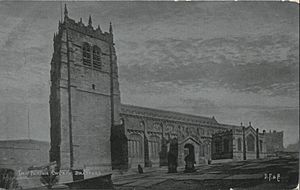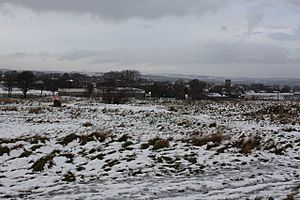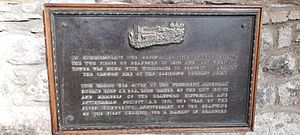Sieges of Bradford facts for kids
Quick facts for kids Sieges of Bradford |
|||||||
|---|---|---|---|---|---|---|---|
| Part of English Civil War | |||||||
 Bradford parish church before extensions were added. This is mostly how the church would have looked in 1642. |
|||||||
|
|||||||
| Belligerents | |||||||
| Earl of Newcastle (1643) | Sir Thomas Fairfax (1643) | ||||||
| Strength | |||||||
| Approximately 800 (1642) | Approximately 400 (1642) | ||||||
| Casualties and losses | |||||||
| Unknown | Unknown | ||||||
The sieges of Bradford were two short battles that happened in the town of Bradford, Yorkshire. They took place in December 1642 and July 1643. These events happened during the English Civil War, a big fight between the King's supporters (called Royalists) and Parliament's supporters (called Parliamentarians).
In the first siege, the people defending Bradford misunderstood a Royalist officer. He asked for "quarter," meaning mercy or surrender. But the defenders thought he wanted to be "quartered," which meant being cut into pieces! This led to the saying "Bradford Quarter." The Royalists later used this saying against Bradford's defenders in the second siege.
The second siege is famous for a strange event. The Earl of Newcastle, a Royalist leader, was said to have been visited by a ghost-like figure. This figure begged him to "pity poor Bradford." Because of this, the town was saved from a massacre.
During both sieges, people in Bradford hung large bales of wool from the church tower. They hoped this would protect the church from cannonballs. After the second siege, Bradford suffered greatly. There was not enough food, and many people got sick. Some historians believe this allowed Leeds to become more important in the region.
Contents
Why Bradford Was Important to Fight Over
Bradford was involved in the First English Civil War from late 1642 to early 1644. The town was attacked twice during this time. In the 1640s, Bradford was a small town with only three main roads. Most people living there were Puritans, who strongly supported Parliament.
There were many reasons why Bradford supported Parliament:
- King Charles I had a Catholic wife, and some thought he might be Catholic too.
- The King had sold Bradford's land to people in London to pay his debts.
- A new vicar (church leader) was put in the local church. He had "papist sympathies," which meant he seemed to favor Catholics.
- A powerful family, the Tempests, tried to tax Bradford's cloth industry. This money would go to people in the south of England.
- Problems with the cloth trade also made people angry at the King.
Before the war really started, Royalist soldiers were sent to Bradford. They knew the town was against the King. These soldiers were very harsh to the people of Bradford. This only made the townspeople dislike the Royalists even more. Yorkshire, where Bradford is, saw many small fights and big battles.
The First Attack: December 1642
The first attack on Bradford began in October 1642. Royalist forces from Leeds were told to attack Bradford because they knew the locals were getting ready to defend themselves. The Royalists set up two cannons on a hill about one mile from the church.
After a short fight with some cannon fire, the battle stopped. Heavy snowfall and strong winds made it too hard to fight. Also, one of the Royalist cannons broke apart. The Royalists soon left and went back to Leeds.
Later, on December 18, the Royalists returned to Bradford. They had about 800 men, while Bradford's defenders had only about 400. The Royalists positioned themselves in Barkerend, which was a separate area from Bradford at the time.
The defenders gathered around the church. They hung wool bales from the church tower to protect it from cannon fire. A drawing from 1643 shows the tower covered with rows of wool bales. Because the Royalists were only about 300 paces away, the wool also helped the defenders. It allowed their best shooters to hide in the tower.
During this first attack, a Royalist officer rode his horse towards the church. He wanted to attack the people inside. But the Parliamentarians fought him off. When he cried out for "quarter" (mercy), the townspeople misunderstood. They thought he meant to be "quartered" (cut into pieces). This event became known as "Bradford Quarter."
The Royalists were eventually forced back and had to retreat. Sir John Goodricke, 1st Baronet, a Royalist leader, was captured and whipped on his feet. Twenty-five other Royalists were taken prisoner. Colonel Goring was wounded but managed to return to his side.
Some people gave credit for this victory to Fairfax, even though he had left before the fighting. However, this story was good for Parliament's cause. It showed that ordinary people could win against professional soldiers. This made people believe God was on their side. In truth, the Royalists lost because they were too confident. They used only a small part of their army. They were also fighting against people who were defending their homes and families. This first siege was also called the Battle of the Steeple because of the wool bales on the church.
The Second Attack: July 1643
Sir Thomas Fairfax was in Bradford during the summer of 1643. But he believed the town could not hold out against the 10,000 Royalists who were approaching. So, he rode out to meet them with his 3,000 to 4,000 men. Fairfax had hoped to get 6,000 more soldiers from Nottingham. However, another Parliamentarian leader, Captain John Hotham, convinced others that the real danger was elsewhere. So, Fairfax did not get the extra troops.
At the end of June 1643, the Battle of Adwalton Moor happened about three miles east of Bradford. This left Bradford open to a Royalist attack. The two armies met at Adwalton Moor by accident. Both sides had hoped to surprise the other. Fairfax's army had some early success, but they were eventually surrounded. They had to retreat southwest along a lane that led to Halifax. This helped them escape without many losses.
With the Parliamentarians scattered towards Halifax, the Earl of Newcastle ordered his army to march on Bradford. Some Parliamentarians did retreat to Bradford. When Newcastle's troops surrounded the town, those on horseback managed to escape. But those on foot could not get out. During the escape, Sir Thomas Fairfax's wife was captured. However, the Earl of Newcastle returned her to Fairfax the next day.
The Royalists fired cannons and made fake attacks. This made the defenders lose hope and waste their ammunition. Sir Thomas Fairfax suggested surrendering, but neither side trusted the other. More small fights happened during the night. The Parliamentarians ran out of lead and gunpowder. Fairfax and his officers left the town to its fate in the early hours of July 2, 1643.
The Earl of Newcastle was said to have told his men to give the townspeople "Bradford Quarter." However, the next day, the Earl changed his mind. While staying overnight at Bolling Hall, he was disturbed three times by a girl in white. She begged him to "pity poor Bradford." Many people have different ideas about what this meant. But the next morning, the Royalist troops took over the town mostly peacefully. Some historians say a massacre would not have fit Newcastle's usual behavior. He may also have been encouraged by the release of 200 Royalist prisoners and the news that Fairfax had left Leeds.
Royalist forces left Bradford in February and March 1644, thanks to John Lambert. Sir John Belasyse tried to take the town back on March 25, 1644, but his attack failed.
What Happened After the Sieges
After the second siege in 1643, Bradford suffered greatly. There was not enough food, and a sickness spread. Some say it took 100 years for Bradford to fully recover. Because of this, Bradford lost its importance in the area. Leeds then became the main trading center.
In 1951, the Bradford Historical and Antiquarian Society placed a plaque in Bradford Cathedral. It says: "To commemorate the two sieges of this church during the two sieges of Bradford in 1642 and 1643 when the tower was hung with woolsacks to protect it from cannon fire of the besieging Royalist Army."



